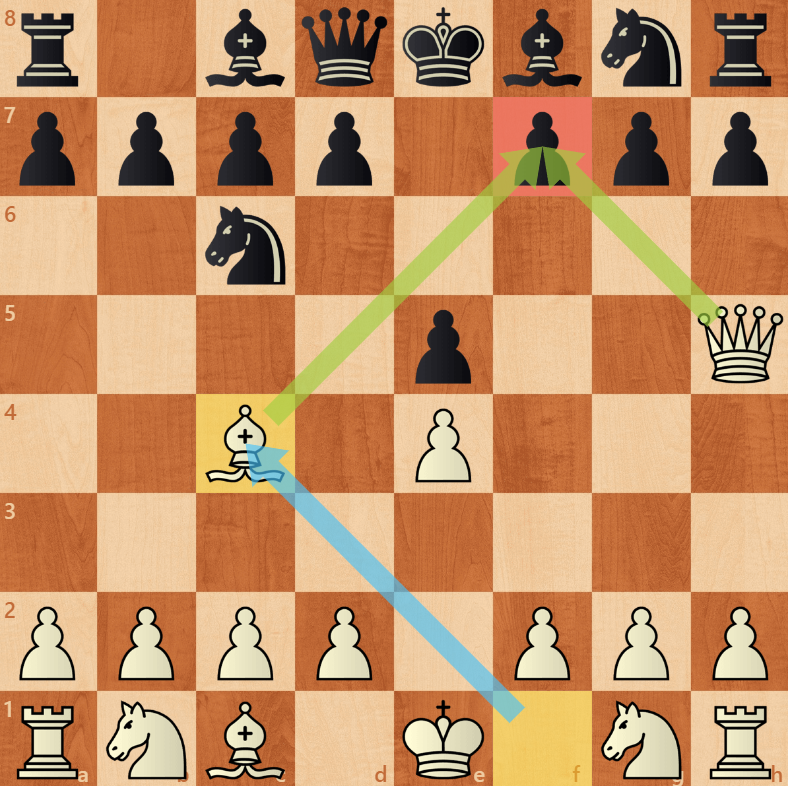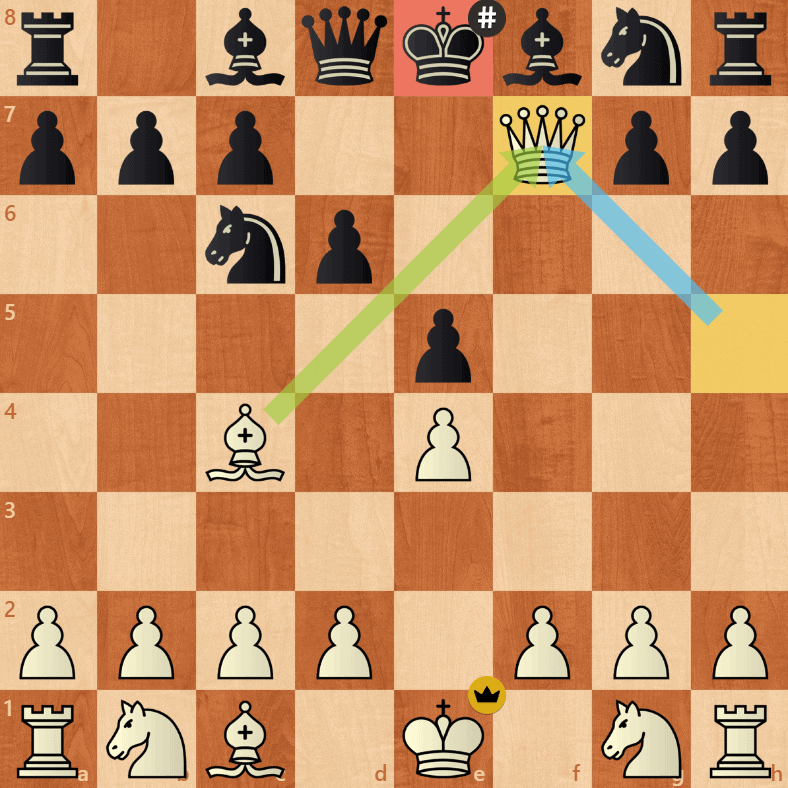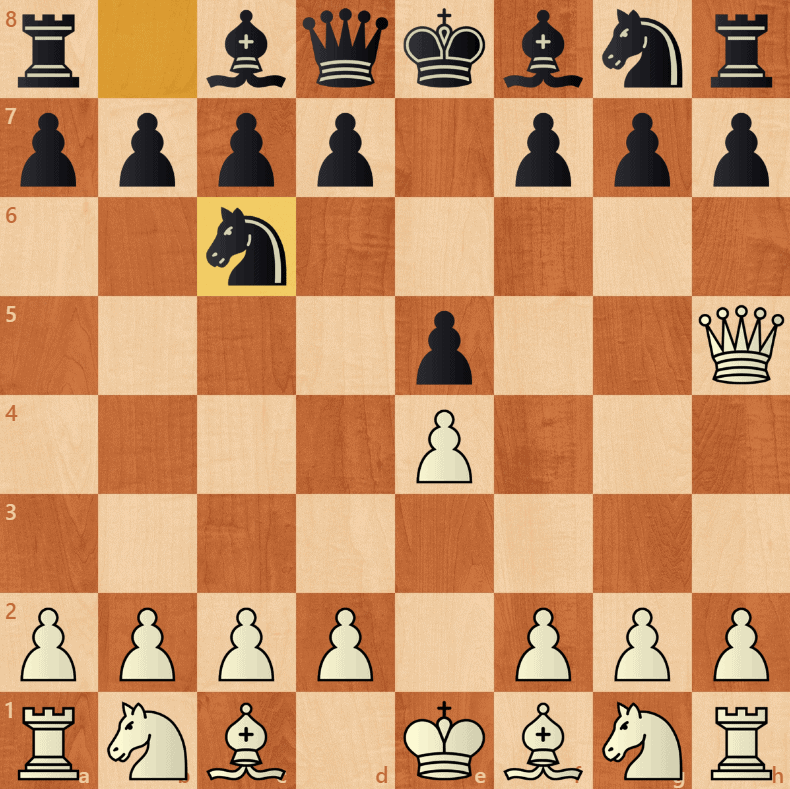While playing chess, there are only a few things more embarrassing than getting checkmated in 4 moves. To prevent this from happening to you, you need to know how this opening trick is performed and know how to prevent it. Scholar’s mate, which is also known as the 4 Move Checkmate, is a great way to win some of your first games in a blink of an eye and it will really impress your friends.
If you are looking for the fastest way to win a chess game, then this checkmate is worth the try. So are you ready to learn how to 4 move checkmate and leave your friends in awe? Follow these basic steps and you’ll be on your way to winning more chess games than you think.
Learn beginner tactics through our free Fundamental Tactics course! Practice your tactics on Hercules Chess’ practice tools by playing rated puzzles and puzzle rush today.
Here is how to win chess in 4 moves:
- Move your King’s pawn to e4
- Black plays 1…e5
- Move your queen all the way to the h5 square
- Black plays 2…Nc6
- Move your light-squared bishop to the c4 square
- Black plays Nf6
- Deliver checkmate by capturing the black pawn on f7. (The king is checkmated)
Four Move Checkmate Explained
Here are the steps to checkmate in four moves:
Step #1
First, move the pawn in front of your King two squares forward to open up lines for your queen and the f1 bishop. Black should reply with the symmetrical 1. e5.

Step #2.
Bring your Queen out diagonally as far as she can: go to h5 square. Your opponent should develop his knight to c6, protecting his vulnerable pawn on e5.

Step #3.
Develop your bishop to the c4 square. The Queen and Bishop should be attacking the black pawn on f7. If your opponent is not paying attention or is not aware of this sequence, they may forget to protect their f7 pawn.

If black plays any move that doesn’t protect their f7 pawn the Four move checkmate is finally delivered when the Queen moves or captures on the f7 square (checkmate #).
The king cannot help himself because none of his forces can render him assistance nor can he escape to a less endangered square. As you can see in the example, the white queen is able to deliver checkmate because of the backup from the c4 Bishop.

Black ignored the deadly threat to f7 and allowed the white Queen to capture the pawn, giving a swift and deadly checkmate.
Related Post: 10 Brutal chess tactics for beginners
Tips to Remember when Checkmating in 4 moves
Queen out, Bishop out, bash! Is a quick and easy way to remember this checkmate. If you follow each step, you’re bound to catch some people out with Scholar’s mate.
It is vital, however, that you develop your pieces accurately. If you miss out on a move or advance your Queen or Bishop to the wrong squares, your chances for a quick victory will be lost. You might even lose your Queen.
Here is an example where the Four-Move checkmate fails if white plays inaccurately.

White is not yet ready to execute the Scholar’s mate. His light-squared bishop is not yet developed on the c4 square to back up the Queen. If the white queen were to take the f7 pawn at this state of the game, white would lose their queen and be devastated.
Our second example shows that the b5 bishop has gone a square too far and can’t protect the White Queen to deliver mate. Instead, the Bishop should be on c4. This is a classic example of a chess blunder and should be avoided at any cost.

How To Defend Against The Scholar’s Mate?
At least once in your chess career, you will encounter the four-move checkmate and you should be prepared to defend against it in a precise fashion. Stopping the four-move checkmate is just as simple as executing it.
You don’t want to become a victim of this cunning strategy and it’s really easy to defend against it once you pay close attention to your opponent’s move. In order to defend against the Four Move Checkmate, here are three things you need to bear in mind:
1. Which Pawn Is The White Queen Attacking?
Your immediate answer might be f7, but think carefully. Capturing the f7 pawn would spell disaster for the white Queen because she is not yet defended by her Bishop. You could simply take her with the black King. In fact, the Queen is attacking the e5 pawn, which is why you should develop your b8 Knight to defend it.
2. How Can You Stop the Deadly Mate Threat
That’s the next question you should ask yourself. You know that the white Queen wants to capture on f7, so you have to stop her. The answer is to move the g7 Pawn one square forward, blocking the path of the attacking Queen and forcing her to retreat or die. Be careful though, if your knight is not developed on c6 and you make the move g7, you fall into a classic 4-move checkmate trap and lose both the e5 pawn and your h8 rook.
3. How To Handle The Persistent Player.
This time white is attacking f7 from a different angle. All black needs to do is block the threat by moving his g8 Knight to f6. As long as you remember to block the Queen, you will never fall for the four-move checkmate.
Why the Four-Move Checkmate is not recommended in serious Tournaments.

If you are looking for a solid chess opening as white to play in an official chess tournament, then the 4 move checkmate is not worth playing. I only showed you so you can play it against your friends and stunt on them 🙂
Playing the 4 move checkmate against a stronger opponent is not a wise decision as your forces can easily be kicked back leaving you with a cramped and passive position. Development of your pieces is more important than a quick attack at the beginning of the chess game.
Black will simply develop his pieces and at the same time will gain valuable tempo by kicking your Queen around the chessboard.
However, if you are persistent to play the 4-move checkmate in serious tournaments, then you should at least know the opening line up to 10 moves ahead assuming that your opponent survived the first move. With that said, let’s dive deeper into some mainlines of the Scholar’s mate and how you should continue to play.
Scholar’s Mate – Qe7 Mainline
The Qe7 mainline of the Scholar’s mate begins with 1.e4 e5 2.Qh5 Qe7!
2…Qe7 is a great response to the Scholar’s mate. It immediately stops any of white’s plans by protecting the e5 and f7 pawns. The only drawback to this move is that the Queen blocks the dark-squared Bishop from developing. On the other hand, Black is not too worried about it, since he can fianchetto his Bishop via g6.
It should be noted that 3. Bc4 would be irrelevant in this case since black has already eliminated the threat of the 4-move checkmate.
3. Nc3 Nf6 Black develops his Knight and attacks the enemy Queen at the same time. 4.Qe2 Nc6 5.Nf3 h6 6.a3 b6 (Both players are trying to play flexibly. They are not in any rush)7. Qc4 Bb7 (an excellent square for the white Queen and frees the light-squared Bishop) 8.Be2 Qe6! (Black does the same. He’s not afraid to double his pawns to have a strong center) 9.0-0 Bd6 10.Qxe6 dxe6 11.d3 Nd7
We’ve come to the end of the main line. From evaluating the position, black does have a slight initiative with the f5 pawn break in the center. On the other hand, white needs to open up lines for his Rooks and try to play for an advantage in the center.
Scholar’s Mate – Nc6 Mainline
The Nc6 mainline of the scholar’s mate begins with 1.e4 e5 2.Qh5 Nc6. Black defends against the threat of Qxe5 in a precise fashion and is one of the most popular defenses to the Scholar’s mate. 3.Bc4 g6 4.Qd1 Bg7. Placing the white Queen on any other square apart from Qd1 would just cause it to get kicked around the board via Nd4 or d6. White is now down a tempo which is a consequence of moving your Queen so early in the game. 5.Nf3 Na5 6.Be2 d5 7.d3 Nc6 8.Bg5 Nge7 9.exd5 Qxd5 10.Nc3 Qd8 11.0-0 h6 12.Bd2 0-0
Evaluating the position, Black is better in development and his Bishops are more active. On the other hand, white’s light square and dark square Bishops are left passive. To solve this problem, white can fianchetto his light square Bishop via Re1, Bf1, g3, and Bg2. Like in our previous example, Black has the initiative by playing the f5 pawn break.
Conclusion – Should You Play The Four Move Checkmate?
The four-move checkmate is a great way to surprise your friends and win some of your first games. I will recommend the four-move checkmate if you are playing blitz or bullet games. You’ll actually be surprised at how many weaker players fall for the trap.
On the other hand, I would not recommend you play it against a stronger opponent or in tournaments when there are enough minutes on the clock. Your forces will fall behind and White would have the advantage as early in the opening.






